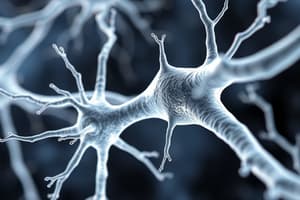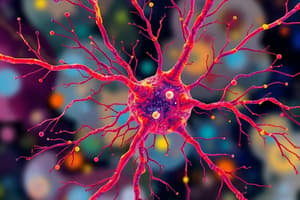Podcast
Questions and Answers
What is the primary function of dendrites in a neuron?
What is the primary function of dendrites in a neuron?
Which statement best describes interneurons?
Which statement best describes interneurons?
How does the myelin sheath enhance axonal function?
How does the myelin sheath enhance axonal function?
What distinguishes efferent neurons from afferent neurons?
What distinguishes efferent neurons from afferent neurons?
Signup and view all the answers
What are the nodes of Ranvier, and what is their function?
What are the nodes of Ranvier, and what is their function?
Signup and view all the answers
What unique function do neurons serve in the brain?
What unique function do neurons serve in the brain?
Signup and view all the answers
Which of the following components is NOT typically found in a neuron's cell body?
Which of the following components is NOT typically found in a neuron's cell body?
Signup and view all the answers
What is the primary role of the myelin sheath in neurons?
What is the primary role of the myelin sheath in neurons?
Signup and view all the answers
In terms of signal direction, what do afferent pathways primarily do?
In terms of signal direction, what do afferent pathways primarily do?
Signup and view all the answers
What characteristic shape is unique to neurons compared to other cells?
What characteristic shape is unique to neurons compared to other cells?
Signup and view all the answers
What connects multiple neurons into functional groups known as neural networks?
What connects multiple neurons into functional groups known as neural networks?
Signup and view all the answers
Why is the loss of a few neurons from a neural network often not noticeable?
Why is the loss of a few neurons from a neural network often not noticeable?
Signup and view all the answers
What is one of the key properties of neurons that facilitates changes in behavior?
What is one of the key properties of neurons that facilitates changes in behavior?
Signup and view all the answers
What is the primary function of the axon in a neuron?
What is the primary function of the axon in a neuron?
Signup and view all the answers
What is the role of the myelin sheath in vertebrate axons?
What is the role of the myelin sheath in vertebrate axons?
Signup and view all the answers
Which part of the neuron is responsible for releasing chemicals to transmit signals to other neurons?
Which part of the neuron is responsible for releasing chemicals to transmit signals to other neurons?
Signup and view all the answers
What distinguishes afferent axons from efferent axons?
What distinguishes afferent axons from efferent axons?
Signup and view all the answers
What defines the axon hillock's role in a neuron?
What defines the axon hillock's role in a neuron?
Signup and view all the answers
How many axons can a neuron have?
How many axons can a neuron have?
Signup and view all the answers
What is a characteristic feature of dendrites in neurons?
What is a characteristic feature of dendrites in neurons?
Signup and view all the answers
What are nodes of Ranvier?
What are nodes of Ranvier?
Signup and view all the answers
Study Notes
Neuron Structure and Function
- Neurons vary in function but some generalizations can be made
- The axon from each neuron connects to many others
- Neurons communicate with each other, forming a network
- The human brain has approximately 100 billion neurons
- Neurons comprise about 50% of the brain's volume
- Neurons make up only 10% of brain cells
- Glial cells support neurons
- The neuron was identified as the brain's unit by Santiago Ramón y Cajal (1887-1903)
Neuron Function
- Neurons are information-processing units in the nervous system
- They acquire, store, interpret, and pass information
- They regulate body functions like breathing, heartbeat, and body temperature
- Neurons work in groups of hundreds or thousands to produce behavior
- Understanding neuron function and interconnection is important
Neuron Networks
- Functional groups of neurons (neural networks) connect brain and spinal cord areas
- Loss of a few neurons in a network is not noticeable; it's the network that produces behavior
- Mapping the structural connectivity (connectome) of the human brain is ongoing
- Neurons are both distinctive and adaptable (plastic)
Neuron Activity
- Neurons are dynamic; continuously producing/losing branches and connections whilst you observe them
- This dynamic activity shapes both stable behaviors and behavioral changes
Neuron Anatomy
- A neuron contains a nucleus, membranes, mitochondria, ribosomes, and other typical animal cell components
- Larger neurons have dendrites, soma (cell body), axon, and presynaptic terminals
- Tiniest neurons lack axons, or well defined dendrites
- Motor neurons have their soma in the spinal cord
- Motor neurons receive excitation from other neurons through dendrites and conduct impulses to a muscle
- Sensory neurons are specialized at one end to be sensitive to specific stimuli (e.g., touch); they also conduct impulses along the axon to one end of the axon
- Sensory neurons, for example, transmit touch information from the skin to the spinal cord; the soma is located on a stalk
Dendrites
- Dendrites are branching fibers narrowing toward their ends; shaped like a tree
- Dendrite surface has specialized synaptic receptors
- The surface area of dendrites corresponds with how much information they can receive
- Some dendrites have many branches increasing surface area
- Dendrites have dendritic spines increasing the surface area
- Shape of dendrites enormously varies between neurons and even in a given neuron over time
- Shape of dendrite is important for combining multiple inputs
Cell Body (Soma)
- The cell body or soma contains the nucleus, ribosomes, mitochondria, and other structures found in most cells
- Much of the metabolic work happens in the soma
- Cell body sizes range from 0.005mm to 0.1mm in mammals and up to a millimeter in certain invertebrates; covered with synapses
Axon
- The axon is a thin fiber typically longer than dendrites; carrying information
- Axons are constant in diameter
- Axons transmit impulses to other neurons, glands, or muscles
- Many vertebrate axons have a myelin sheath with interruptions (Nodes of Ranvier)
- An axon branches, and each branch tip forms a presynaptic terminal (end bulb/bouton)
- Chemicals cross the junction between neurons here
- Each neuron has a single axon carrying messages to other neurons
Axon Anatomy continued
- The axon begins at the axon hillock at one end of the cell body
- Axons can branch into one or multiple axon collaterals
- Axon collaterals usually branch at a right angle
- A neuron can have many dendrites but only one axon
- Axon lengths can vary quite a bit (spinal cord to your feet);
- Other terms associated with neurons: afferent, efferent, intrinsic
- Afferent axon brings information into a structure, efferent axon carries information away from a structure
Additional Important Considerations
- Every sensory neuron is afferent to the rest of the nervous system, every motor neuron is efferent from the rest of the nervous system
- Within the nervous system, neuron is an efferent from one structure and an afferent from another
- If a cell's dendrites and axon are entirely within a single structure, the cell is an interneuron
Studying That Suits You
Use AI to generate personalized quizzes and flashcards to suit your learning preferences.
Related Documents
Description
Test your understanding of the structure and function of neurons in the nervous system. This quiz covers neuron communication, the role of glial cells, and the formation of neural networks. Dive into the fascinating world of neurology and see how neurons impact our behavior and bodily functions.



